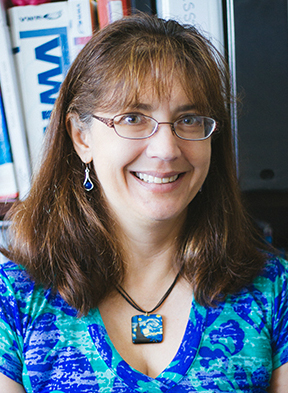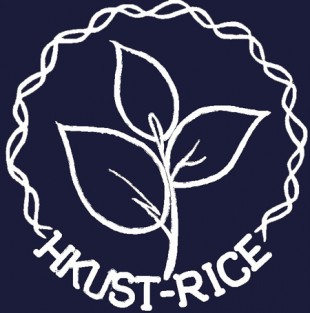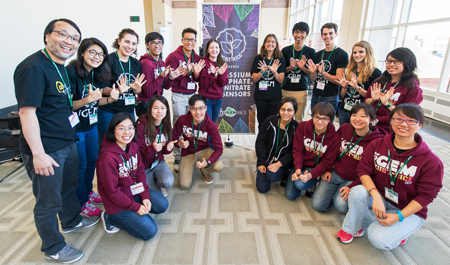BY BETH BEASON-ABMAYR
Rice University and the Hong Kong University of Science and Technology (HKUST) recently fielded the first transcontinental team in the history of the International Genetically Engineered Machine competition (iGEM) in Boston. The students brought home a raft of awards and honors, but the best prize of all was the unique experience they received simply by working together and learning from one another for the past seven months. It is no exaggeration to say the experience was life-changing.
IGEM is the world’s premier undergraduate synthetic biology competition, and Rice’s first big splash there was in 2008, when six students who called themselves the Synthetic BiOWLogists entered BioBeer and walked away with runner-up honors for best presentation. Joff Silberg, myself and several other Rice faculty members with a growing interest in synthetic biology helped mentor the team, and their strong showing brought international recognition to Rice’s efforts in synthetic biology, an emergent field that aims to create living organisms with biological functions not found in nature.
Student interest in iGEM waned at Rice, but I was hooked, and I returned as a judge, first for regional qualifiers and later for the 2011 World Jamboree. I served as co-head judge of the World Jamboree in 2012-2014 and am now a member of the iGEM executive judging committee.
At the 2014 competition, I ran into King Chow, a friend and former iGEM judge who is director of HKUST’s interdisciplinary programs office and professor of life science and biomedical engineering. King and I got to talking about the close ties that Rice already had with HKUST, and I said, “Wouldn’t it be cool if we had a joint Rice-HKUST iGEM team next year?”
The final piece fell into place in January, when Rice freshman Peter Tang emailed to ask if Rice had a 2015 team. I contacted King, and we began discussing strategies for project coordination, exchange of ideas and funding. HKUST agreed to cover the team’s registration fee, and students began signing on almost immediately.
For their project, students settled upon the idea of creating a bacterium that would change color to let gardeners know if their soil had the correct mix of nitrogen, phosphorous and potassium. It was an ambitious goal, and accomplishing it would require thousands of hours of laboratory experiments, not only to create the necessary genetic circuits but also to insert them into tame forms of E. coli and conduct the necessary experiments to prove that they worked.
The group eventually attracted 31 undergraduate members — 13 from Rice and 18 from Hong Kong. Rice team members included students majoring in biochemistry and cell biology, bioengineering, chemical and biomolecular engineering, physics and computational and applied math.
One of the most significant educational opportunities arose when HKUST offered to provide housing for six Rice undergraduates to work on the project in Hong Kong during June and July. Seven other team members worked on the project at Rice throughout the summer. Travel funding — both to Hong Kong and Boston — was generously provided by Rice’s Wiess School of Natural Sciences, George R. Brown School of Engineering, departments of both BioSciences and Bioengineering and from Rice Professor George Phillips and the Howard Hughes Medical Institute Foundation.
In all, eight Rice students and 10 from HKUST attended the 2015 iGEM Jamboree in Boston Sept. 24-28, many of whom met for the first time when they practiced their 20-minute oral presentation and final poster presentation in Boston.
The students accomplished much toward their goal of creating potassium, nitrate and phosphate biosensors. You can read more about the research on the team’s wiki at http://2015.igem.org/Team:HKUST-Rice. The team’s work earned a gold medal and a nomination for Best Environment Project, one of only four nominees out of 40 teams. In addition, the team’s potassium-sensing promoter, a new genetic circuit that the students added to the iGEM Registry of Standard Biological Parts, was one of five nominees for the coveted Best New Basic Part honor out of all 259 competing teams.
I am extremely proud of what the students achieved in such a short time. At its heart, iGEM is an educational program that is having enormous impact on thousands of student lives, and as an educator, that’s what matters most to me. The enthusiasm of everyone there is inspiring, and hundreds of professional synthetic biologists volunteer their time to serve as judges and mentors.
The way I see it, iGEM gives Rice students a unique opportunity — early in their undergraduate experience — to both get excited about laboratory research and to take ownership of their very own project. It also provides early and invaluable training on both written and oral communications because each team must present its findings to an international community of scholars.
But the best measure of iGEM’s success are the words of the students:
- “Thank you so much for allowing me to have one of the greatest experiences of my life here in Hong Kong!”
— Ashkan Rohani, sophomore in chemical and biomolecular engineering - “(IGEM taught me) that efforts for scientific research should contain elements from completely different disciplines — social sciences, humanities, etc. — in order to help scientists maximize their positive impacts for society.”
— John Luke Garcia, sophomore in physics - “This experience definitely emphasized the importance of a global perspective in scientific research. I am so grateful to have had the opportunity to participate in a truly unconventional research experience.”
–Kendall Burks, junior in biochemistry and cell biology - “By traveling to Hong Kong and directly collaborating with students at HKUST, I realized how cultural exchange provides a unique opportunity to share different approaches to solving problems.”
–Shilpa Nataraj, senior in biochemistry and cell biology and in psychology - “IGEM is an extremely rewarding hands-on educational experience in understanding not only the concepts of synthetic biology but also whether lab work is something that you truly enjoy.”
–Steven Hao-Jen Chen, sophomore in bioengineering - “It was a great privilege to attend the 2015 Jamboree and represent Rice with seven other students. Meeting (others who are) passionate in the exact same field as you is mind-blowing.”
–Zilu Peter Tang, sophomore in bioengineering
The 2015 Rice-HKUST team instructors included King Chow and Jessica Tang from HKUST, and Joff Silberg and myself from Rice. Additional advisers included graduate students David Zong and Joshua Atkinson from Rice’s Ph.D. program in Systems, Synthetic and Physical Biology and HKUST students Raul M. Cuellar, Hojeong Bonnie Park, Jordy Evan Sulaiman, Ho Yin Bosco Wong, Nadia Benedicta Bongso, Tsz Ching Chloe Tang and Jacqueline Theeng Mei Aw.
–Beth Beason-Abmayr is a professor in the practice in the Department of BioSciences at Rice University





Leave a Reply